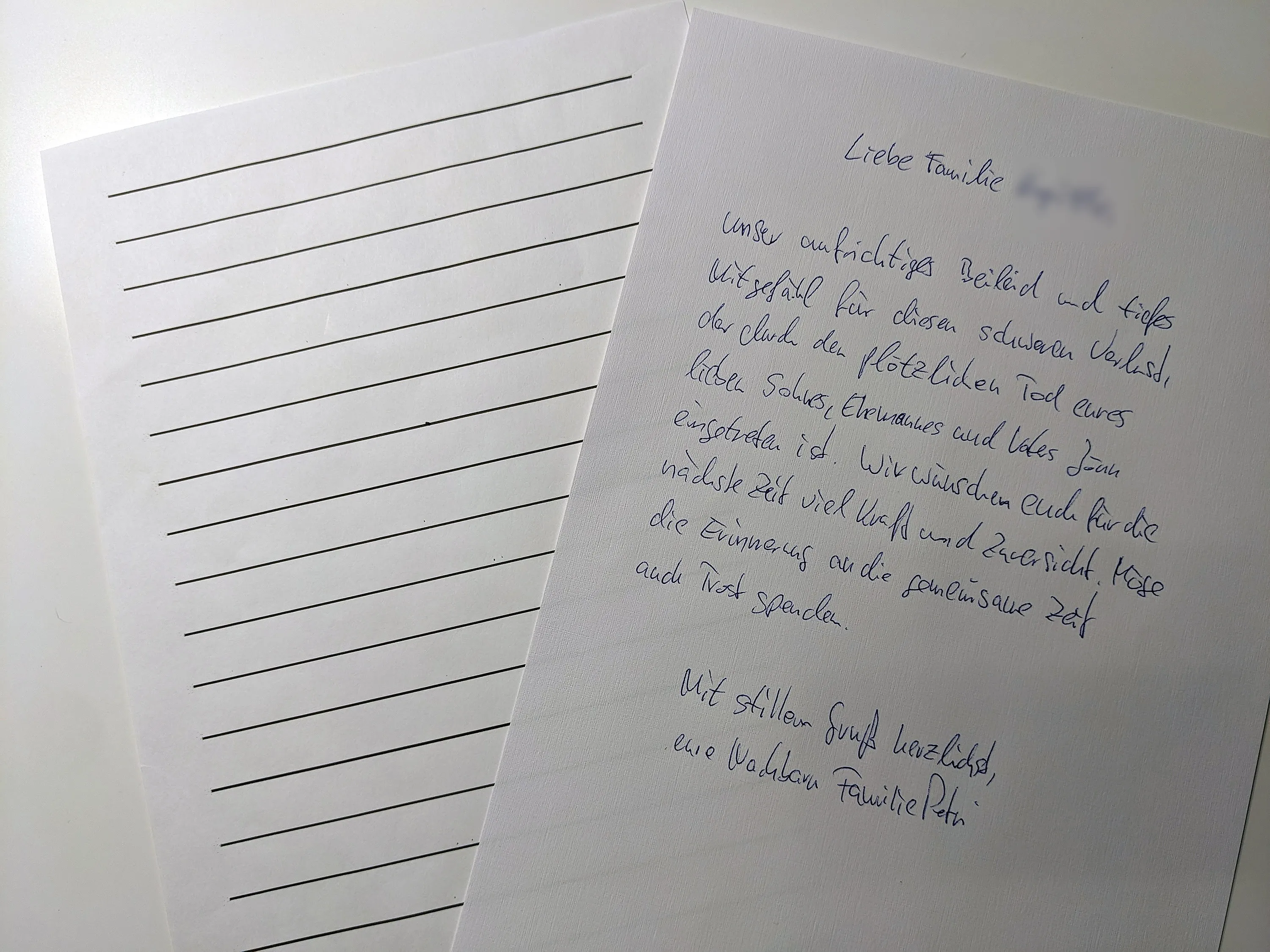Writing condolence cards can be a real challenge, especially when it comes to finding the right words for a condolence message. Whether you are looking for just a few short and beautiful words or want to formulate a loving farewell, a condolence card should always come from the heart.
In this post, I will show you how to write a condolence card that truly provides comfort. You will learn which condolence card messages are suitable, how to design a loving and personal card, and how to write a condolence letter that does justice to the occasion. Without stiff formalities, but simply and empathetically. Let's together find out how to find the right words in difficult times.
Table of Contents
Occasions for a Condolence Card
Writing a condolence card is a loving gesture to express sympathy and support in difficult times. There are various occasions where such a card is appropriate. Here are some of the most common situations where you could write a condolence card:
Death in the Family
The loss of a family member is always particularly painful. In such moments, it is important to support the relatives and show them that they are not alone. A condolence card can provide comfort and express your sincere condolences. Whether it is the death of a parent, a sibling, or another close relative, a compassionate message can mean a lot.
Loss of a Friend
Even when a friend passes away, the pain is often great. Friends are like the family we choose, and their loss leaves a deep void. A condolence card to the family of the deceased friend or to mutual friends can help share the pain together and memories.
Death of a Colleague or Neighbor
The death of a colleague or neighbor may not initially seem as impactful as the loss of a family member or close friend, but a condolence card is also appropriate here. Colleagues and neighbors are often an important part of our daily lives, and their death can also leave a gap. A card can express sympathy here and honor the connection one had with that person.
Unexpected or Tragic Deaths
Sometimes death comes completely unexpectedly and tears a deep hole in the lives of the survivors. Accidents, sudden illnesses, or other tragic circumstances make the loss particularly difficult to bear. In such cases, a condolence card is a way to provide comfort and alleviate the feeling of helplessness.

Death of a Child
The death of a child is probably one of the hardest losses one can imagine. Finding the right words here is particularly difficult. A compassionate condolence card can show the parents that they are not alone in their grief and that the child will not be forgotten.
Death of a Pet
For many people, pets are like family members. The death of a beloved pet can also cause deep pain. A condolence card to someone who has lost their pet can provide comfort and show that you understand and sympathize with their grief.
Long Illness and Release
Sometimes death comes after a long illness, and although the loss hurts, there may also be a certain relief that the deceased no longer has to suffer. In such cases, a condolence card can express both sorrow and relief, and show the survivors that you are thinking of them.
Commemoration Days and Anniversaries
Even after the official mourning period, there are occasions where a condolence card is appropriate. Commemoration days and death anniversaries are moments when memories of the deceased are particularly present. A card on such days shows that you have not forgotten the deceased person and are still thinking of the survivors.
Regardless of the occasion, the most important thing in a condolence card is the sincerity and compassion you express in it. It is about providing comfort to the bereaved and showing them that they are not alone in their grief.

Choosing the Right Card for Writing Sympathy Cards
Choosing the right sympathy card is the first step to express your compassion and condolences appropriately. Not only the text, but also the design and quality of the card play an important role. Here are some aspects you should consider when making your selection:
Design and Layout
The design of the sympathy card should be simple and respectful. Subtle colors like white, gray, beige, or pastel tones are often the best choice. Darker colors such as black or navy are also common as they reflect the mourning and seriousness of the situation. Avoid bright colors and striking patterns that may seem inappropriate.
The layout should be clear and uncluttered, without too many distracting elements. A simple motif, such as a flower, a tree, or a cross, can be fitting. Sometimes cards with nature motifs like sunsets or landscapes are a good choice as they convey calmness and peace.
Paper Quality
The quality of the paper also contributes to how the card is perceived. High-quality, thick paper not only feels better but also shows that you have made an effort. Glossy paper can look elegant, while matte paper exudes a simple elegance. Choose what you like best and what suits the recipient's personality.
Sender's and Recipient's Personal Preferences
Knowing the recipient's preferences can be helpful in choosing the card. Some people prefer religious motifs and quotes, while others may prefer more neutral or nature-themed designs. Your own relationship with the deceased and the bereaved can also influence the choice of the card. Adding a personal touch can make the card even more meaningful.
Pre-printed or Blank Cards
Pre-printed cards with condolences or poems are a good choice if you have difficulty finding the right words. They provide a base that you can complement with your own thoughts. If you prefer to write a completely personal message, blank cards are the better option. Here you have the freedom to write exactly what you want to express.
Handwritten or Printed?
A handwritten message is always more personal and shows that you have taken the time. Even if your handwriting is not perfect, the gesture will surely be appreciated. However, if you have to write a lot of cards or your handwriting is hard to read, you can also print the text. In this case, make sure to choose a readable font and structure the text clearly.
When writing sympathy cards, it is important that the message is neat and legible. To ensure that your lines stay straight and even, you can place a lined paper under your writing paper. The lines of the paper will shine through the writing paper and serve as a guide, allowing you to effortlessly write beautiful, straight lines. This simple method helps you make your card visually appealing and present your text cleanly and neatly.

Purchased or Handmade?
While purchased cards are often professionally designed and of high quality, a handmade card can be especially personal and valuable. If you are creative and enjoy crafting, you could design an individual sympathy card. A self-designed layout or personal illustration can give the card a unique touch.
Choosing the right sympathy card requires some thought and empathy. Ultimately, however, it is the gesture and genuine condolences you express that matter most. A carefully chosen card can bring comfort to the bereaved and show them that you are thinking of them in these difficult times.
Formal and Personal Salutation in Writing Sympathy Cards
The correct salutation in a sympathy card is crucial to express your condolences and respect. Depending on how close you are to the recipients, the salutation can be formal or personal. Here are some tips on choosing and wording the appropriate salutation:
Formal Salutation for Unknown Recipients
If you do not know the bereaved well, a formal salutation is appropriate. This shows respect and politeness, which is particularly important in such a sensitive context. Here are some examples of formal salutations:
- "Dear Mrs. Müller,"
- "Dear Mr. Schmidt,"
- "Dear Meier Family,"
- "Dear Mrs. Müller," (if a slightly more personal note is desired)
After the salutation, you can begin your text by expressing your sympathy and condolences.

Personal Salutation for Friends and Family
A more personal salutation is more appropriate for close friends and family members. It creates a familiar and warm atmosphere and shows that you are closely connected to the recipients. Here are some examples of personal salutations:
- "Dear Anna,"
- "Dear Thomas,"
- "Dear Schneider Family,"
- "Dear Aunt Maria,"
Here as well: After the salutation, the actual text of your sympathy card follows, in which you express your feelings and sympathy.
Combined Salutation for Multiple Recipients
Sometimes the sympathy card is addressed to several people, for example, to the entire family of the deceased. In this case, you can use a combined salutation:
- "Dear Müller Family,"
- "Dear Anna, dear Thomas," (if you want to address individual family members directly)
These salutations show that you are thinking of all recipients and expressing your condolences to them collectively.
Tips for Salutation and Introduction
- Avoid overly informal or casual salutations that could seem inappropriate in such a context.
- Be respectful and empathetic in your choice of words.
- Adapt the salutation to the relationship you have with the recipients. The closer the relationship, the more personal the salutation can be.
- After the salutation, you can start with a compassionate sentence expressing your condolences. For example: "I was deeply saddened to hear about the loss of your mother."
Example of Introduction after the Salutation
- "Dear Mrs. Müller, I was deeply shocked to hear about the passing of your husband. Please accept my heartfelt condolences."
- "Dear Anna, I am incredibly sorry to hear about the loss of your brother. My thoughts are with you and your family during this difficult time."
The right salutation and a compassionate introduction lay the groundwork for a respectful and comforting sympathy card. They show the recipients that you are there for them in their grief and will not leave them alone.

The Text: What Should be Included When Writing a Sympathy Card?
The text in a sympathy card is the heart of it, through which you express your sincere condolences and sympathy. It is often not easy to find the right words, but a few basic elements can help you compose a compassionate and appropriate message. Here are some points to consider in your text:
Expression of Sympathy
Begin your sympathy card by expressing your deep sympathy and condolences. This shows the recipients that you are thinking of them and regret their loss.
Examples:
- "I am incredibly sorry to hear about your loss."
- "I was deeply saddened to hear about the passing of your father."
- "My sincere condolences during this difficult time."
Memories of the Deceased
If you knew the deceased personally, you can share beautiful memories or special moments. This can provide comfort to the bereaved and show them that the deceased is appreciated and will be fondly remembered.
Examples:
- "I will never forget how warm and friendly your mother always was. Her warmth touched many people."
- "Your brother was a wonderful friend who was always there for me. I will greatly miss our shared experiences."
Man lebt zweimal:
das erste Mal in der Wirklichkeit,
das zweite Mal in der Erinnerung.
Honoré de Balzac
French WriterOffering Support and Comfort
Offer the bereaved your support and help. It is important that they know they are not alone in their grief and can rely on you.
Examples:
- "If you need someone to talk to or help with anything, please do not hesitate to contact me."
- "I am here for you anytime you need me."
Religious or spiritual words (if appropriate)
If you know the recipients are religious or spiritual, appropriate words from their belief system can provide comfort. Be sure to be sensitive and respectful.
Examples:
- "May God grant you comfort and peace in this difficult time."
- "My prayers are with you and your family."
Conclusion and final words
End your sympathy card with a closing sentence that emphasizes your compassion once again. This rounds off your message and leaves a lasting impression.
Examples:
- "With deepest sympathy,"
- "With quiet regards,"
- "With sincere condolences,"

Examples of complete sympathy card texts
Example 1:
Dear Anna,
With deep sorrow I learned about the passing of your father. I am incredibly sorry to hear about your loss. Your father was a wonderful person, always kind and helpful. I will miss his warmth and our conversations greatly. If you need someone to talk to or help with anything, please do not hesitate to contact me. I am here for you anytime.
With deepest sympathy
[Your Name]
Example 2:
Dear Mrs. Müller,
With great sadness, I learned about the passing of your husband. Please accept my heartfelt condolences. Your husband was a remarkable person whose smile and kindness touched many people. May God grant you comfort and peace in this difficult time. My prayers are with you and your family.
With sincere condolences
[Your Name]
The most important thing when writing a sympathy card is that the words come from the heart and are sincere. Show compassion, share memories, offer support, and find a comforting conclusion. This way, your sympathy card will provide comfort and support to the bereaved during this difficult time.
Find even more examples in our blog post: Heartfelt Condolences - The Top 100 for Comfort and Support

The Right Time to Write and Send Sympathy Cards
Choosing the right time to write and send a sympathy card is just as important as the content of the card itself. Here are some guidelines and considerations that can help you choose the right moment:
Immediately after receiving the news of the death
It is advisable to write and send the sympathy card as soon as possible after receiving the news of the death. A timely message shows the bereaved that you are thinking of them and supporting them in their grief. It is a gesture of immediate sympathy that can be particularly comforting in the first days after the loss.
If you learn of the loss later
Sometimes you only learn of the loss weeks or even months after the passing. In these cases, it is also appropriate to send a sympathy card. In your card, you can mention that you only recently learned of the sad event and still want to express your deepest sympathies. The bereaved will appreciate that you took the time to think of them.
Example:
Dear Müller Family,
With great delay, I have only now learned of your painful loss. Please accept my sincere condolences. My thoughts are with you during this difficult time.
With deepest sympathy
[Your Name]
Special Memorial Days
Even on special memorial days such as the first anniversary of the death or the birthday of the deceased, it can be comforting to send a card. Such gestures show that you have not forgotten the deceased and that you also think of the surviving relatives when these days are particularly difficult for them.
Example:
Dear Anna,
Today marks the anniversary of the loss of your beloved mother. I am thinking of you and sending you much strength and love. May the memory of her bring you comfort.
With warm regards
[Your Name]

Personal and Social Consideration
When choosing the timing, consider the personal and social circumstances of the surviving relatives. In some cultures or families, there are specific mourning periods or rituals that you should respect. If necessary, inform yourself about these to appropriately show your sympathy.
Tips for the Right Timing
- Immediate Action: If possible, write and send the condolence card as soon as possible after receiving the news of the death.
- Delayed Reactions: If you learn about the loss later, still send the card to express your sympathy.
- Memorial Days: Use special memorial days to send comfort and sympathy again.
- Respect and Sensitivity: Pay attention to the personal and cultural customs of the surviving relatives.
The right timing for sending a condolence card shows the surviving relatives that you are thinking of them and respect their grief. A timely and well-thought-out message can provide much comfort and give them the feeling that they are not alone in their mourning.

Common Mistakes When Writing Condolence Cards
When writing a condolence card, it is important to be empathetic and respectful. However, mistakes can easily happen that can make the message less comforting or even hurtful. Here are some common mistakes and tips on how to avoid them:
1. Writing Too Formally or Distantly
Too formal or distant language can come off as cold and impersonal. Condolence cards should always have a personal and warm touch.
Avoid:
- "Dear Schmidt Family, in deep sorrow and sincere sympathy."
Preferred:
- "Dear Schmidt Family, with deep sympathy, I think of you and your painful loss."
2. Being Too Informal or Casual
On the other hand, the language should not be too casual or colloquial, as this can undermine the seriousness of the situation.
Avoid:
- "Hey, I'm really sorry to hear what happened. That's really tough."
Preferred:
- "Dear Anna, I am incredibly sorry to hear about your loss. My thoughts are with you during this difficult time."
3. Using Clichéd or Empty Phrases
Standardized phrases can seem impersonal and superficial. Try to find your own words that express your sincere sympathy.
Avoid:
- "I know exactly how you feel."
Preferred:
- "I can only imagine to some extent how difficult this loss must be for you. Please know that I am here for you."

4. Giving Inappropriate Advice
Grief is a very personal process, and unsolicited advice can be inappropriate. Instead, you should simply express your condolences.
Avoid:
- "You need to stay strong."
- "It will be okay."
Instead:
- "I wish you strength during this difficult time."
- "My thoughts are with you."
5. Making Overly Religious Statements
If you are unsure whether the bereaved are religious, strongly religious statements may be inappropriate. Be sensitive and respect the recipients' beliefs.
Avoid:
- "It was God's will."
Instead:
- "I hope that your faith brings you comfort during this difficult time."
6. Addressing the Cause of Death
It is not always appropriate to mention the circumstances of death in a condolence card, especially if they are painful or traumatic.
Avoid:
- "I'm so sorry he died in the accident."
Instead:
- "I'm deeply sorry to hear about his sudden passing. My thoughts are with you."

7. Writing Long Texts Without Paragraphs on Condolence Cards
Long, unstructured texts can be difficult to read. Paragraphs and a clear structure help to better convey the message.
Avoid:
- Writing continuous text without paragraphs.
Instead:
- Structure the text into paragraphs to clearly highlight important thoughts and feelings.
8. Not Making a Personal Offer of Support
Show that you are willing to help, but be specific and honest in your offer.
Avoid:
- "Let me know if you need anything." (too general)
Instead:
- "I'm here for a chat anytime or if you need practical help."
9. Forgetting to Sign Your Own Name
In group or corporate cards, it's easy to forget to clearly indicate the sender. Make sure your card is personally signed.
Avoid:
- Signing with "The team at..."
Instead:
- Personally sign, e.g., "With heartfelt regards, [Your Name]"
10. Writing Too Much About Yourself
The condolence card should focus on the bereaved and the deceased, not on yourself and your own feelings.
Avoid:
- "I am so sad and don't know how to deal with it."
Instead:
- "I am thinking of you and wish you strength during this difficult time."
By avoiding these common mistakes, you can ensure that your condolence card is respectful, empathetic, and comforting. The bereaved will appreciate your sincere condolences.
Writing condolence cards is a heartfelt gesture that shows you are thinking of the bereaved and standing with them in their grief. With the right words, a caring design, and the right timing, you can provide comfort and sincerely express your sympathy. Avoid common mistakes, choose appropriate condolences, and take the time to craft your message personally and empathetically. By following these tips, your condolence card will be a valuable support for the bereaved, showing them that they are not alone in their difficult time.

